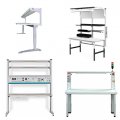This layer of organic semiconductor material is situated between two electrodes. Generally, at least one of these electrodes is transparent. OLED technology is used mostly in two ways – as a source of light for backlighting of traditional LCD displays, for example in mobile phones, and second field of usage is to produce directly a display where every pixel is created by an OLED element. One of the biggest advantages of OLED displays is their minimal thickness of only few mm and moreover OLED display can be flexible. Because OLED display generates light itself, no other backlight is used. Thus, it can display deep black levels and can be thinner and lighter than liquid crystal displays. In low ambient light conditions such as dark rooms, an OLED screen can achieve a higher contrast ratio than an LCD , which are using either cold cathode fluorescent lamps or the more recently developed LED backlight.
In our offer we have alphanumerical displays series EAW from Electronic Assembly. They provide a contrast ratio of minimum 2000:1, thanks to their real black background and active technology. Series EAW have an extremely fast 10us response time, which stays fast even at icy temperatures. Great advantage over standard LCD modules is their ability to provide a full contrast even at -40°C. No limitation in viewing angle and no need for contrast adjustment belong to another advantages in comparison to LCD displays. EAW displays have an integrated controller (HD44780-like) and already as a standard, they provide all important characters sets: English, Japanese, European and Cyrillic – all these are stored in ROM from production. Further, up to 8 characters can be defined by user. Displays can work with 5V or 3.3V without modification, highest brightness can be reached with 5V operation. Current consumption is, depending to the display size and content, between 15~50mA (typ.). Some types are available in two versions – light green and icewhite. You can download an EAW datasheet with detailed information.
Recently, probably the main drawback of OLED technology was their limited life time. This problem is solved by a new patented technology, and displays do reach a life time of 14 khours even at +80°C (half brightness). The probable life time at room temperature is more than 100 khours. Thanks to these improvements and their ability to work at icy conditions are EAW displays suitable also for industrial applications.
In case of interest about OLED displays please contact us at info@soselectronic.com.
- high contrast ratio 2000:1
- operating range -40 to + 80°C, full contrast even at -40°C
- extremely fast response time – 10 us
- no contrast adjustment necessary
- no limitation in viewing angle
- consumption 15-50mA, supply 3.3-5V
- 3 integrated character sets (all in one)
- 8 user defined characters
Do you like our articles? Do not miss any of them! You do not have to worry about anything, we will arrange delivery to you.


















